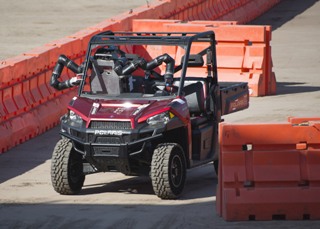Jun 10 2015
Showing off its robustness and versatility, the ape-like RoboSimian robot, developed at NASA's Jet Propulsion Laboratory, Pasadena, California, took fifth place in the DARPA Robotics Challenge (DRC) Finals, held June 5 through 6 in Pomona, California.
 RoboSimian Driving. JPL's RoboSimian drives a four-wheeled vehicle through a slalom course at the DARPA Robotics Challenge Finals.
RoboSimian Driving. JPL's RoboSimian drives a four-wheeled vehicle through a slalom course at the DARPA Robotics Challenge Finals.
RoboSimian squared off against 22 other robots in the international robotics competition, which promoted the development of robots that could respond to disaster scenarios too dangerous for humans.
"I couldn't be more proud of our team and their performance in such challenging circumstances," said Brett Kennedy, principal investigator for RoboSimain at JPL. "The robot didn't fall once, and we never had to reset it, confirming how versatile and dependable RoboSimian really is."
RoboSimian and its competitors faced a variety of complex tasks during the tournament. Each robot had one hour to:
- Drive a vehicle through a slalom course and then exit the vehicle
- Open a door
- Turn a wheel to open a valve
- Cut a hole in a half-inch-thick panel of drywall using a cordless power drill
- Cross a field of debris or walk over uneven terrain
- Walk up a set of stairs
In addition to the tasks known in advance, DARPA officials gave competitors an additional surprise task each day. These included throwing a switch on an electrical panel and pulling a plug from an electrical socket and reinserting it.
After the first day of the two-day competition, RoboSimian was in third place in the overall standings. The robot completed seven of the eight tasks with 12 minutes remaining in the hour available for its run. Day two saw the JPL team complete the course with 6 points at the end of the hour. Teams were scored on the best of their two runs.
"In the final run, we got hung up on the wall challenge," said Kennedy. "We initially left a little bit of the painted circle that was supposed to be removed in our cut. We eventually got it, but it ate a lot of our time. The surprise task of moving an electric plug from socket to socket is a difficult problem in general, and we had never practiced anything like it. We certainly gave it our best, but in the end the ticking clock forced us to abandon that task to make sure we had time for the debris. In the end, we ran out of time to make it up the stairs at the end of the course."
Making the challenge even more difficult, the JPL group and the other teams faced degraded communications as they tried to control their robots. DARPA officials had planned this element of the competition to mimic the disorientation of a disaster scenario.
Designed to traverse complicated terrain and perform dexterous tasks, RoboSimian has four generic limbs for maneuvering and manipulation. To further minimize its complexity -- something engineers accustomed to designing interplanetary robots think about a lot -- the robot uses just one type of actuator (a kind of motor) in each of its limbs' 28 articulated joints. So that the robot can see its environment and the operators can understand it, RoboSimian is equipped with seven sets of stereo cameras and a LiDAR (Light Detection and Ranging) device for mapping its environment in 3-D.
With the DARPA competition now in the rear-view mirror, the RoboSimian team will focus on refining the robot's design and autonomous capabilities for real-world applications on Earth, underwater and in space.
"Beyond responding to disasters, our goal is for RoboSimian and future robots with the same limb technology to extend humanity's reach," Kennedy said.
The DRC Finals are the culmination of a nearly three-year program to develop robots capable of assisting humans in responding to natural and man-made disasters. The challenge was launched in the wake of the 2011 earthquake and tsunami that devastated the Tohoku region of Japan, with the goal of better preparing humans to confront the threats posed by future disasters. Through two preliminary rounds of competition, DARPA and the DRC teams redefined what is possible in supervised autonomy, physical adaptability and human-machine control interfaces.
The RoboSimian team at JPL is collaborating with partners at the University of California, Santa Barbara, and the California Institute of Technology in Pasadena. Caltech manages JPL for NASA.